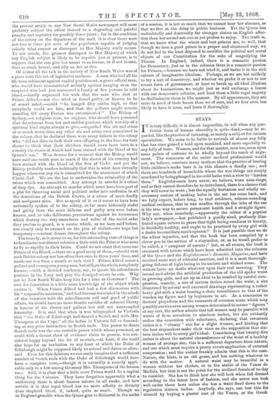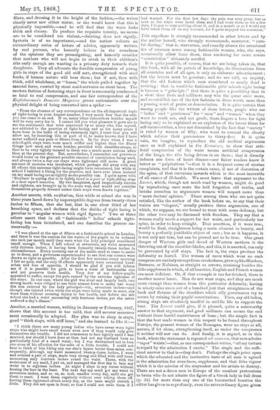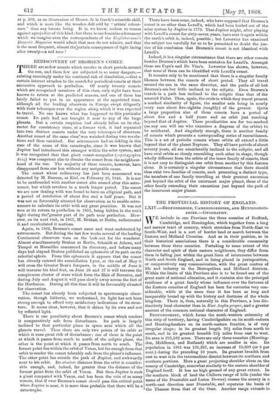STAYS.
IT is very difficult, it is almost impossible, to tell when any par- ticular form of human absurdity is quite dead,—may be re- garded, like the practice of tattooing, as merely a subject for curious speculation. We seem to be liable to revivals of almost any folly that has once gained a hold upon mankind, and more especially to any folly of taste. Women, and for that matter, men too, seem upon some points of costume to be wholly beyond the reach of argu- ment. The consensus of the entire medical professional would not, we believe, convince many mothers that the practice of leaving little children's necks bare is in this climate a deadly one ; and there are hundreds of households where the wee things are simply murdered by being plunged in ice-cold baths with a view to " harden them." Englishwomen have never, we believe, worn nose-rings, and as they cannot therefore be re-introduced, there is a chance that they will never be worn ; but the equally barbarous and wholly un- necessary custom of making holes in the ear has come back, and we fully expect, before long, to read evidence, solemn-sounding medical evidence, that to run needles through the lobe of the ear is the true way to secure permanent health and a straight figure. Why not, when somebody,—apparently the editor of a popular lady's newspaper,—has published a goodly sized, profusely illus- trated square octavo to prove that tight lacing conduces to beauty, is decidedly healthy, and ought to be practised by every girl with a desire to conciliate men's opinion? It is just possible that we do the editor injustice, and that the book has been compiled by a clever pen in the service of a staymaker, or, as he would prefer to be called, a " composer of corsets ;" but, at all events, the book is crammed with letters which have been admitted into the columns of the Queen and the Englishwoman's Domestic Magazine, and have received some sort of editorial sanction, and it is a most thorough- going defence of tight lacing in its ancient and wicked sense. The writers leave no doubt whatever upon their real meaning. They intend and advise the artificial production of the old spider waist in growing girls, and set up an ideal to be reached by careful com- pression, namely, a size of sixteen inches round the waist, a size illustrated by several well executed drawings representing a rather heavy girl with a waist bearing a close resemblance to that of the wooden lay figure used by beginners in art. As a concession to doctors' prejudices and the remnants of common sense which may possibly survive even among women determined to secure " figures " at any cost, the author admits that tall women may be passable with waists of from seventeen to nineteen inches, but she evidently makes the concession with reluctance, declaring that seventeen inches is a " clumsy" size for a slight woman, and hinting that the best staymakers make their vices on the supposition that six- teen inches will be every girl's ideal. Considering that twenty-five inches is about the natural circumference of the waist of a healthy woman of average size, this is a sufficient departure from nature, and one which must require a pretty severe application of external compression ; and the author frankly admits that this is the ease. Nature, she hints, is an old goose, and has nothing whatever to do with the matter. A natural waist may be beautiful in a woman without her clothes, or in the statue of the Venus de Medicis, but that is not the point for the civilized female of to-day to consider. She has to think how she will look when full dressed according to the latest laws of fashion, and she never can look well under those laws unless she has a waist fined down to the regulation sixteen inches. Anybody, she says, can test this for himself by buying a plaster cast of the Venus, or the Greek Slave, and dressing it in the height of the fashion,—the writer clearly never saw either statue, or she would know that this is physically impossible,—and he will find that the waist looks thick and clumsy. To produce the requisite tenuity, no means are to be considered too violent,—fainting does not signify, hysteria is of no importance,—and the author collects an -extraordinary series of letters of advice, apparently written by real persons, who honestly believe in the soundness of the opinions they are promulgating, and honestly consider that mothers who will not begin to crush in their children's ribs early enough are wanting in a primary duty towards their daughters. They all advocate the forcible compression of young girls in stays of the good old stiff sort, strengthened with steel busks, if human nature will bear them ; but if not, then with thick, solid whalebone, or " bones," the whole pulled together by manual force, exerted by stout maid-servants on stout laces. The modern fashion of fastening stays in front is summarily condemned as fatal to real compression, and one fair correspondent of the Englishwoman's Domestic Magazine grows enthusiastic over the physical delight of being converted into a spider :—
" From the absence of any correspondence on the all-important topic of tight-lacing in your August number, I very much fear that the sub- ject has come to an end. If so, many other subscribers besides myself will be very sorry for it. I cannot tell you what pleasure it gave me to see the sentiments that were expressed by so many who, like myself, are addicted to the practice of tight-lacing, and as for many years I have been in the habit of lacing extremely tight, I trust that you will Allow me, by inserting this or part of it, to make known that I have „never suffered any pain or illness from it. In the days when I was a school-girl, stays were worn much stiffer and higher than the flimsy things now used, and were, besides, provided with shoulder-straps, so -that to be very tightly incased in them was a much more serious affair than at the present day. Bat, nevertheless, I remember our governess would insist on the greatest possible amount of constriction being used, and always twice a day our stays were tightened still more. A great -amount of exorcise was inculcated, which perhaps did away with any ill effects this extreme tight-lacing might have occasioned, but while at school I imbibed a liking for the practice, and have ever since insisted -on my maid lacing me as tightly as she possibly can. I quite agree with Staylace" in saying that to be tightly laced in a pair of tight-fitting stays ,is a most superb sensation. My two daughters, aged respectively sixteen and eighteen, are brought up in the same way, and would not consider .themselves properly dressed unless their stays were drawn together."
Another asserts, with exultation, that while at school she was in -three years laced down by imperceptible degrees from twenty-three inches to fifteen, that she lost, that is, one clear third of her breathing space, and declares that the dislike of tight lacing is peculiar to "angular women with rigid figures." Two or three .others assert that in all " fashionable " ladies' schools tight- lacing has been introduced, and one describes the process un- reservedly :—
" I was placed at the age of fifteen at a fashionable school in London, and there it was the custom for the waists of the pupils to be reduced -one inch per month until they were what the lady principal considered small enough. When I left school at seventeen, my waist measured only thirteen inches, it having been formerly twenty-three inches in -circumference. Every morning one of the maids used to come to assist us to dress, and a governess superintended to see that our corsets were 'drawn as tight as possible. After the first few minutes every morning I felt no pain, and the only ill effects apparently were occasional head- aches and loss of appetite. I should be glad if you will inform me if it is possible for girls to have a waist of fashionable size and yet preserve their health. Very few of my fellow-pupils Appeared to suffer, except the pain caused by the extreme tightness of the stays. In one case, where the girl was stout and largely built, two .strong maids were obliged to use their utmost force to make her waist the size ordered by the lady principal—viz., seventeen inches—and :though she fainted twice while the stays were being made to meet, she wore them without seeming injury to her health, and before she left school she had a waist measuring only fourteen inches, yet she never suffered a day's illness."
Another, a married woman, writing in January or February, 1867, shows that this account is too mild, that still severer measures must occasionally be adopted. Her plan was to sleep in stays, good " thick stays, with stiff bone," and she learned to like it :—
" I think there are many young ladies who have never worn tight stays who might have small waists even now if they would only give themselves the trouble. I did not commenoe to lace tightly until I was married, nor should I have done so then had not my husband been so particularly fond of a small waist ; but I was determined not to lose ,one atom of his affection for the sake of a little trouble. I could not bear to think of him liking any one else's figure better than mine, con- sequently, although my waist measured twenty-three inches, I went and ordered a pair of stays, made very strong and filled with stiff bone, measuring only fourteen inches round the waist. These, with the -assistance of my maid, I put on, and managed the first day to lace my waist in to eighteen inches. At night I slept in my corset without loosing the lace in the least. The next day my maid got my waist to seventeen inches, and so on, an inch smaller every day, until she got theth to meet. I wore them regularly without ever taking them off, having them tightened afresh every day, as the laces might stretch a little. They did not open in front, so that I could not undo them if I
had wanted. For the first few days the pain was very great, but as soon as the stays were laced close, and I had worn them so for a few days, I began to care nothing about it, and in a month or so I would not have taken them off on any account, for I quite enjoyed the sensation."
This expedient is strongly recommended in other letters and by the author herself, who strongly recommends, moreover, " care- ful dieting," that is, starvation, and roundly abuses the occasional fits of common sense among fashionable women, who, she says, occasionally allow loose dress, thus rendering far more severe "constriction" ultimately needful.
It is quite possible, of course, that we are being taken in, that this book, with all its parade of knowledge, its illustrations from all countries and of all ages, is only an elaborate advertisement ; but the letters must be genuine ; and we are told, ou inquiry, that the old fashion which men considered so nearly dead is reviving ; that iu would-be fashionable girls' schools tight lacing is become a " principle ;" that there is quite a possibility that in a short time fools and milliners may win the game once more, and re-establish one of the few fashions in dress worth more than a passing word of praise or denunciation. It is quite certain that among people like the writers of these letters, people who use " ladies" and " gentlemen" for " men" and "women" when they want to mark sex, and not grade, there lingers a love for tight lacing only to be explained as an explosion of the latent thirst for self-incarceration, a love not diminished by the fact that " society" is ruled by women of fifty, who want to conceal the obesity which refutes their pretensions to thirty-five. It is quite vain, we imagine, to reproduce the old medical arguments once so well explained iu the Examiner, to show that arti- ficial compression of the waist means artificial compression of the lungs, the ribs being driven in on them ; that it directly induces one form of heart disease—our fairer readers know it better as " palpitations "—that it is a frequent cause of uterine complaints, and that it is the certain cause, if not of distortion of the spine, of that curvature inwards which is the most incurable of all causes of ill-health. We must leave that argument to the Lancet, which, though not much read by women, might do good by reproducing once more the half forgotten old truths, and betake ourselves to arguments women will respect more than " mere doctors' opinion." Those among them who are not quite satisfied, like the author of the book before us, to say that their waists are "elegant," usually produce three arguments, one of which, we suppose, we are bound to treat with sonic delicacy, but the other two may be discussed with freedom. They say that a woman really needs a support for her waist, and particularly her spine, in order to keep straight. That assertion, if it were true, would be final, straightness being a main element in beauty, and beauty a perfectly justifiable object of care ; but as it happens, it is not only not true, but can be proved not to be true. One great danger of Western girls and dread of Western mothers is the throwing out of the shoulder-blades, and this, it is asserted, can only be prevented by stiff stays. The fact is, the stays produce the deformity so feared. The women of races which wear no such compress are entirely exemptfrom crookedness, grow uplikeHindoos, Burmese, or Nubians, as straight as arrows, retaining besides the lithe suppleness in which, of all beauties, English and French women are most deficient. Or, if that example is too far-fetched, there is another nearer home. Men do not wear stays, and they are much more exempt than women from this particular deformity, having in ninety-nine cases out of a hundred just that straightness of the back and flatness of the shoulders which silly governesses try to secure by ruining their pupils' constitutions. Then, say old ladies, strong stays are absolutely needful in middle life to support the bust. The Lancet could give, if it pleased, quite a noteworthy answer to that argument, and good milliners can secure the end without these horrid contrivances of bone ; but the simple fact is that the best made women in this respect to be found throughout Europe, the peasant women of the Romagna, wear no stays at all, nature, if let alone, strengthening itself, as under the compresses it neither will nor can do. And finally, it is argued, as in this book, where the statement is repeated ad nauseam, that men admire "taper" waists!—that, as one correspondent writes, "all my torture is repaid by the admiration I excite." The single and the suffi- cient answer to that is—they don't. Perhaps the single point upon which the educated and the instinctive taste of all men is agreed is the admiration for roundness, suppleness, and that lithe vigour which it is the mission of the staymaker and his artists to destroy. There are not a dozen men in Europe of the smallest pretensions to brain who do not admire the figure of a Greek lady in full dress (p. 32) far more than any one of the becorsetted beauties the editor has given us so profusely, even the extraordinary figure given
at p. 203, as an illustration of Messrs. de la Garde's scientific skill, and which is more like the wooden doll sold by " artists' colour- men " than any human being. It is, we know, useless to reason against aprejudice of this kind; but there is one feminine adornment which we imagine even the correspondents of the Englishwoman's Domestic Magazine would admit that men do not admire, and that is the most frequent, almost thecertain consequence of tight lacing after twenty—a red nose !




































 Previous page
Previous page